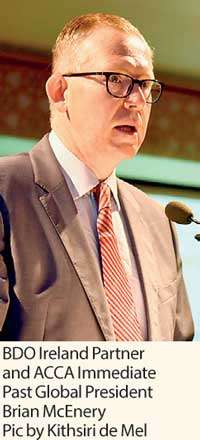18 Jul 2018 - {{hitsCtrl.values.hits}}
 By Shabiya Ali Ahlam
By Shabiya Ali Ahlam
Sri Lanka’s healthcare system needs private sector investment in the medium term, as the public sector would struggle to address challenges stemming from the country’s fast growing ageing population.
While highlighting the opportunities and challenges in Sri Lanka’s healthcare sector, BDO Ireland Partner and ACCA immediate past global President Brian McEnery, asserted that although the public sector is the dominant force in healthcare provision, just as in many other countries, the island nation requires greater contribution from the private sector.
“There is a growing need for social care as the population ages and this will be a growing need. For this the private sector should be able to contribute to ensure the extending of required care,” he said during a breakfast meeting hosted by ACCA in Colombo yesterday.
Before the ageing population phenomenon exacerbates, McEnery pointed out that it is important to ensure the population remains healthy while entering old age, which is considered crucial to get the healthcare system of a country right.
It was said that measures also must be taken to minimize chronic diseases. With non-communicable diseases (NCDs) rising rapidly due to ageing population and lifestyle factors, a shift in that regard has led to a high level of inpatient utilizations compared to other OECD countries. Sri Lanka has achieved below replacement level fertility among developing countries and 30 percent of the population is expected to be elderly by 2030. The health and education authorities were acknowledged for their efforts in focusing on quality education in postgraduate courses to meet the demand of healthcare professionals, although it was observed that the economy continues to face major challenges due to shortage of “quality” experts, limited access to finance and restricted access to land for building of healthcare facilities.
Adding to the increase in expenditure is also the heavy reliance on imported medical equipment and pharmaceuticals drugs.
In terms of facilities, Sri Lanka currently faces an acute shortage of specialist beds for cardiology, surgeries, cancer and neurology, and in terms of human resources, it is estimated that there is a shortage of 14, 000 doctors, and 25, 000 nurses.
As per the latest census data, Sri Lanka has one physician per 1,000 persons.
According to McEnery, opportunities for the private sector to support the public sector-dominant healthcare are in the areas of insurance and education in the medical field.
The local healthcare sector is expected to grow at 11 percent in the medium term with higher growth in the private sector. Along with the increase in GDP, an increase in the annual healthcare expenditure has also been observed since 2012.
Sri Lanka currently spends about US$ 151 per person per year on healthcare, which is significantly low when compared with major developing and developed economies. However, the figure is expected to increase in the coming years.
The trend observed in the current expenditure is that what the country spends on curative measures is much higher than for preventive measures.
17 Nov 2024 17 Nov 2024
17 Nov 2024 17 Nov 2024
17 Nov 2024 17 Nov 2024
17 Nov 2024 17 Nov 2024
17 Nov 2024 17 Nov 2024